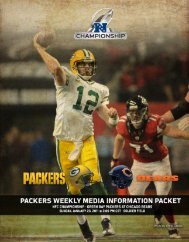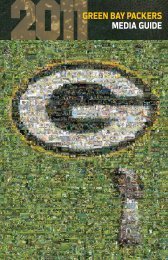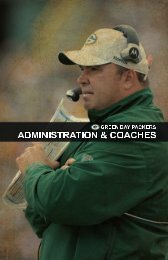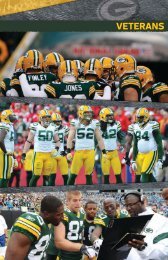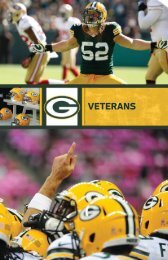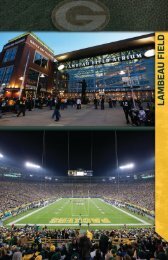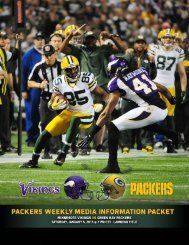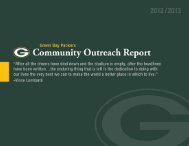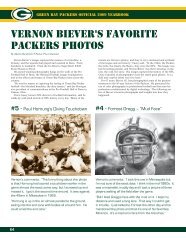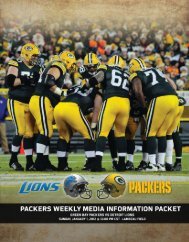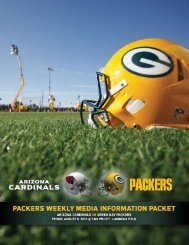Records & History - NFL.com
Records & History - NFL.com
Records & History - NFL.com
- No tags were found...
Create successful ePaper yourself
Turn your PDF publications into a flip-book with our unique Google optimized e-Paper software.
SHAREHOLDER HISTORY & FINANCIAL HISTORYOf all the things that make the Green Bay Packers and their story soincredible and unique, the most significant is simply this: The team isliterally owned by its fans.Presently, 364,114 people (representing 5,014,545 shares) can layclaim to a franchise ownership interest.Shares of stock include voting rights, but the redemption price isminimal, no dividends are ever paid, the stock cannot appreciate in value,and there are no season-ticket privileges associated with stock ownership.No shareholder is allowed to own more than 200,000 shares, a safeguardto ensure that no one individual is able to assume control of the club.The team has had three other owners, all in its first four years, 1919-22. The first owner, Indian Packing Company, paid an unofficial purchaseprice of $500 to supply Curly Lambeau with uniforms and equipment. Inturn, Lambeau and team manager George Calhoun called the club “Packers.”Shortly thereafter, Acme Packing Company bought Indian PackingCompany and all its assets, including the fledgling team. In 1921, Lambeauconvinced new owners John and Emmitt Clair to apply for membership inthe new American Professional Football Association (early <strong>NFL</strong>).With the team already headed for bankruptcy, the APFA revoked thefranchise after Lambeau used illegal college players in a non-league gamelater that year. But before the 1922 season, Lambeau by himself reappliedand the league reinstated the Packers, with Lambeau as owner. When rainthreatened to sink the team in 1922, A.B. Turnbull came to the rescue.Turnbull, publisher of the Green Bay Press-Gazette, grocery manLee Joannes, attorney Gerald Clifford and Dr. W. Webber Kelly cancelledLambeau’s $2,500 debt, then rallied the <strong>com</strong>munity behind the team.In August 1923, with more than 400 in attendance at a local Elks Club,the club was transformed into a nonprofit entity, the Green Bay PackersCorporation. The five men, including Lambeau, were nicknamed theHungry Five.There now have been five stock drives in the 92-year history of theteam. The first stock sale, which took place at that 1923 meeting, sawlocal merchants raise $5,000 by selling 1,000 shares for $5 apiece, with astipulation that the purchaser also had to buy at least six season tickets.The second, in 1935, raised $15,000 after the corporation hadgone into receivership. At that point, the nonprofit Green Bay FootballCorporation was reorganized as the Green Bay Packers, Inc., the present<strong>com</strong>pany, with 300 shares of stock outstanding.The third, in 1950, came on the heels of Lambeau’s 30-year dominion,when the club’s officers arranged to amend the corporation’s bylaws topermit the sale of up to 10,000 total shares of stock (opening up morethan 9,500 shares for purchase), to limit the number of shares that anyindividual could own. The team also increased the number of directorsfrom 15 to 25.The response to the 1950 drive was inspiring, with people from allacross Wisconsin, as well as former Green Bay residents living in otherstates, <strong>com</strong>ing forward to buy the $25 shares of stock. Roughly $50,000was raised in one 11-day period alone. Reportedly, one woman from aEVENTS THAT HELPED TO STABILIZE PACKERS FINANCIALLY, 1922-66523farm near Wrightstown, Wis., showed up at the team’s offices with $25worth of quarters in a match box. A total of about $118,000 was generatedthrough this major stock sale, helping to put the Packers on a soundfinancial basis once again.The fourth came late in 1997 and early in 1998. It added 105,989 newshareholders and raised more than $24 million, monies which were utilizedfor the Lambeau Field redevelopment project. Priced at $200 per share,120,010 shares were purchased by fans during the 17-week sale, whichended March 16, 1998.With the <strong>NFL</strong> supporting the plan, the existing 1,940 shareholdersoverwhelmingly voted to amend the articles of the corporation on Nov. 13,192319351950• A.B. Turnbull’s actions, 1922-23 — When rain threatened to keep fans away and bankrupt the Packers, Turnbull told Lambeau andGeorge Calhoun to play their games and that he’d bail them out of debt. Turnbull then organized local investors, turned team into nonprofitorganization in 1923, and raised $1,000 in team’s first stock drive.• Decision to play games in Milwaukee, 1933 — Allowed Packers to tap larger market. As a result, the Packers nowhave one of the largest territories in sports (the <strong>NFL</strong> has traditionally given teams only 75-mile radius). By playing inboth Green Bay and Milwaukee (1939-94), Packers thwarted any efforts to establish another <strong>com</strong>peting pro footballteam there.• Court decision to appoint receiver, 1935 — After fan who fell from City Stadium bleachers sued Packers, team petitionedfor friendly receiver, while litigation ran its course. Henry Graass, circuit court judge and Packers fan, appointedlocal accountant Frank Jonet as receiver. Despite Great Depression, Packers prospered during receivership (1934-37),thanks in part to growing popularity of <strong>NFL</strong>.• Second stock drive, 1935 — President Lee Joannes raises $15,000 in “Save the Packers” stock drive, getting donationsfrom firefighters, policemen, high school students, housewives, civic leaders and other citizens.• Joe Carr’s sending Don Hutson to Green Bay, 1935 — College star signed two contracts, including one with Brooklyn football Dodgers.League President Joe Carr awarded Hutson to Packers because team’s contract was postmarked earlier. Hutson, pivotal in timely 1936world championship and greatest player in Green Bay history, helped team to climb out of court receivership.• <strong>NFL</strong>’s installation of college draft, 1936 — Kept small-market teams such as Packers <strong>com</strong>petitive with big-city opponents.• Lee Joannes donation, 1937 — Packers president paid $6,000 to settle case of fan who fell from stands in 1934, then convinced court toend receivership period.• Decision to invest in war bonds, 1940s — Money in reserve carried team despite losses of at least $25,000 in 1943 alone, as World WarII depleted rosters.• Intrasquad game, Thanksgiving, 1949 — Packers brought old-timers back, drawing 15,000 to City Stadium, earning $50,000.• Third stock drive, 1950—After Lambeau’s departure, team raised nearly $118,000.• Bert Bell’s push for league-wide TV package, 1950s — With help from Congress, <strong>com</strong>missioner laid groundwork for CBS-TV deal thatallowed all teams, large market and small market, to share revenue, eventually in place by the 1961 season. In 1966, Pete Rozelle signedfirst <strong>NFL</strong> TV package, with CBS and NBC, giving Packers more than $1 million (which allowed Vince Lombardi to sign Donny Anderson tothe team’s first long-term contract).JonetCOMMUNITYSHAREHOLDER HISTORYADMIN. &COACHESDRAFT &VETERANS FREE AGENTS 2012 REVIEWSHAREHOLDERHISTORYLAMBEAUFIELD MISC.



